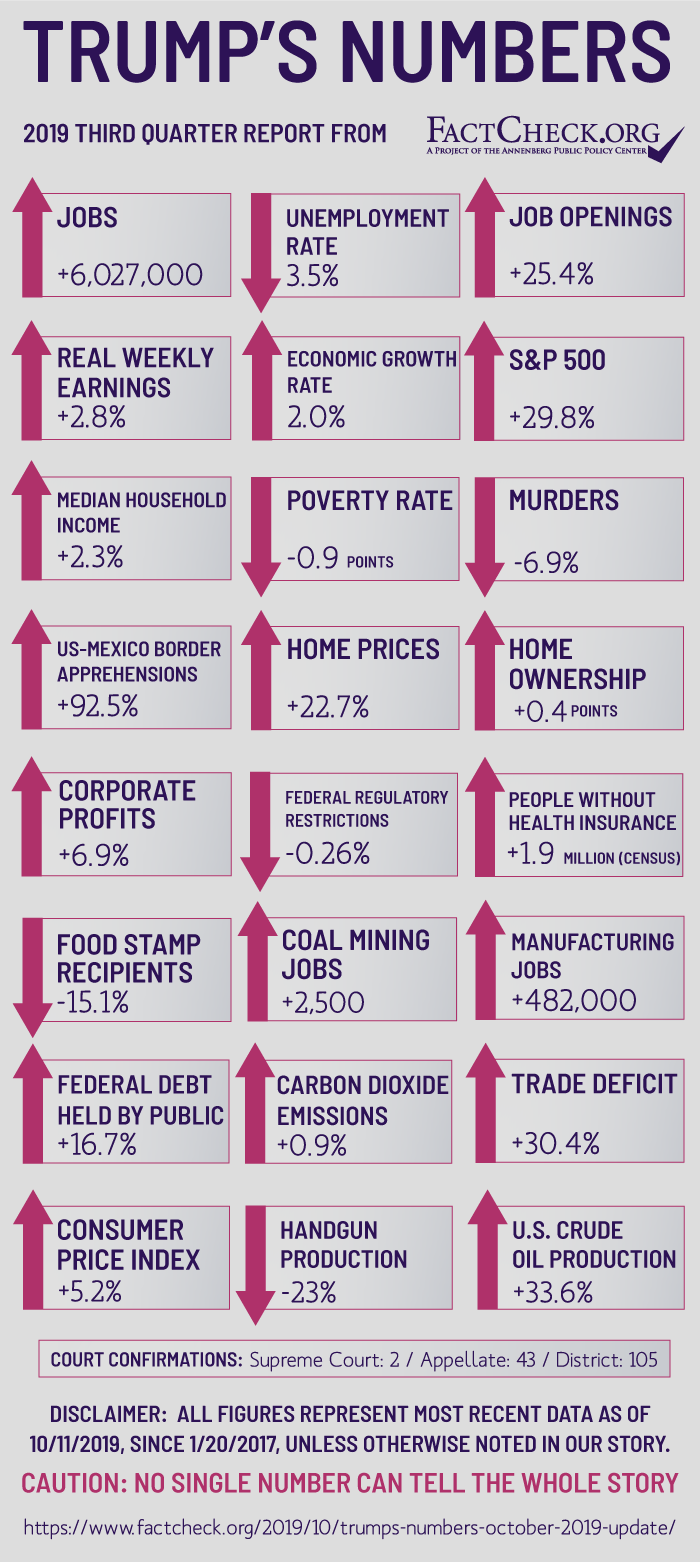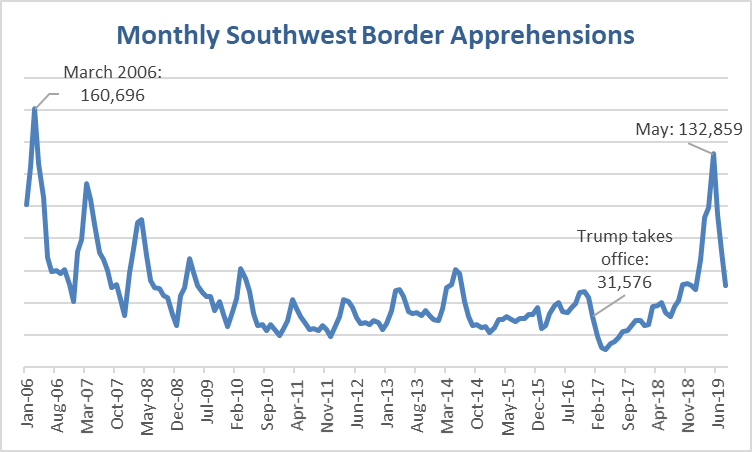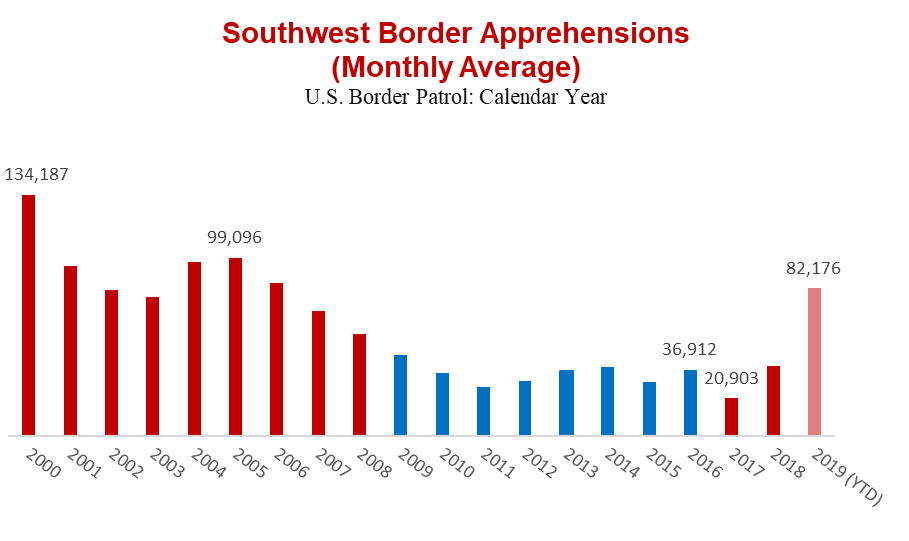Summary
Since President Donald Trump took office:
- The economy added 6 million jobs, and the unemployment rate dropped to the lowest level in nearly 50 years.
- Economic growth fell far short of the annual 4% to 6% Trump promised. The most recent rate is 2.0%.
- The federal debt went up more than $2.4 trillion. The annual deficit hit nearly $1 trillion in fiscal year 2019 – the highest since 2012.
- Median household income rose 2.3%. Average weekly paychecks rose 2.8%. The poverty rate and food stamp rolls declined.
- Stock prices rose: The S&P 500 index was up 29.8%. Single-family home prices rose nearly 23%, hitting a record level in June.
- The trade deficit — which Trump promised to reduce — went up 30%.
- The number of Americans lacking health insurance rose nearly 2 million.
- The number of murders dropped 6.9%. But the number of rapes went up.
- Illegal border crossings nearly doubled, as of the most recent 12 months on record.
- Trump has filled 43 seats on federal appeals courts, compared with 25 filled by Obama at the same point in his first term.
Analysis
This is our seventh quarterly update of the “Trump’s Numbers” scorecard that we posted in January 2018 and have updated every three months, most recently on July 12. We’ll publish additional updates every three months, as fresh statistics become available.
Here we’ve included statistics that may seem good or bad or just neutral, depending on the reader’s point of view. That’s the way we did it when we posted our first “Obama’s Numbers” article seven years ago — and in the quarterly updates and final summary that followed. And we’ve maintained the same practice under Trump.
This update includes comprehensive looks at crime, income and poverty during the president’s first two years in office. The FBI’s report of crime rates for all of 2018 was released Sept. 30, and the Census Bureau’s figures for median annual household income, poverty levels and health insurance coverage during 2018 were released Sept. 10. Other statistics are released quarterly, monthly and sometimes daily, and we include here the most recent available as of this date.
Then as now, we make no judgment as to how much credit or blame any president deserves for things that happen during his time in office. Opinions differ on that.
Jobs and Unemployment
Job growth slowed a bit under Trump, but unemployment dropped to the lowest level in nearly half a century.
Employment — Total nonfarm employment grew by 6,027,000 since the president took office, according to the most recent figures available from the Bureau of Labor Statistics.
That continued an unbroken chain of monthly gains in total employment that started in October 2010. The economy has now added jobs for 108 consecutive months — just shy of nine years — including the first 32 months of the Trump administration.
The average monthly gain under Trump so far is 188,000 — compared with an average monthly gain of 217,000 during Obama’s second term. Trump is far behind the pace needed to fulfill his campaign boast that he will be “the greatest jobs president that God ever created.”
Unemployment — The unemployment rate, which was well below the historical norm when Trump took office, has continued to fall to the lowest rate in nearly half a century.
The Bureau of Labor Statistics now figures the rate was 4.7% when he was sworn in. The most recent rate, for September, fell to 3.5%. That’s the lowest since December 1969, nearly 50 years ago, when it was also 3.5%.
The jobless rate has been at or below 4% for the most recent 19 months — all under Trump. It hasn’t been that low for that long since a 50-month streak ending in January 1970.
The historical norm is 5.6%, which is the median monthly rate for all the months since the start of 1948.
Job Openings — One reason employment growth has slowed is a shortage of qualified workers.
The number of unfilled job openings hit more than 7.6 million in November and again in January, the highest in the 18 years the BLS has tracked this figure.
As of the last day of August, the most recent figure on record, it was nearly 7.1 million. That’s a gain of 1.4 million unfilled job openings — or 25.4% — since Trump took office.
In March of last year the number of job openings exceeded the number of unemployed people looking for work for the first time on record. And that’s been the case in every month since. In August, there were 1 million more job openings than there were people seeking jobs.
Labor Force Participation — Despite the abundance of jobs, the labor force participation rate — which went down 2.8 percentage points during the Obama years — is up slightly under Trump.
The labor force participation rate is the portion of the entire civilian population age 16 and older that is either employed or currently looking for work in the last four weeks. Republicans often criticized Obama for the decline during his time, even though it was due mostly to the post-World War II baby boomers reaching retirement age, and other demographic factors beyond the control of any president.
Since Trump took office, the rate has fluctuated in a narrow range between 63.2% and 62.7%. It was at the high end of that range in September — 0.3 percentage points above where it was the month Trump took office.
Manufacturing Jobs — Manufacturing jobs increased under Trump, but the growth has stalled recently.
The number rose by 482,000 between Trump’s inauguration and September. That followed a net decrease of 193,000 under Obama.
But the early growth during Trump’s term has faded. At first, manufacturing jobs increased even faster than total employment. But Trump’s trade disputes and tariffs have taken a toll on the manufacturing sector. During the first nine months of this year, the number of factory jobs rose 0.2%, while total employment rose four times as fast.
During all of Trump’s tenure, the grown in manufacturing jobs has been 3.9%, below the 4.1% growth for all jobs.
The number of manufacturing jobs is still 896,000 below where it was in December 2007, at the start of the Great Recession.
Economic Growth
The economy grew somewhat faster under Trump — but not at the rate he promised. Gross domestic product was growing at an annual rate of 2.0% during the second quarter of this year, after going up 2.9% in 2018 and a revised 2.4% during his first year in office.
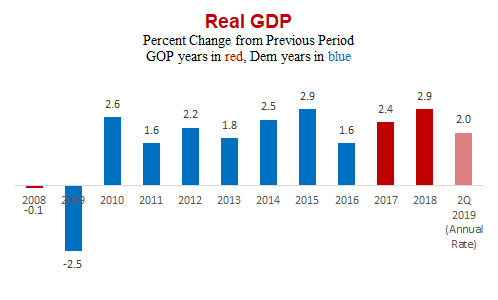
Since our last report, the Bureau of Economic Analysis has upwardly revised its estimate of growth in 2017 by 0.2 percentage points as part of its annual update, using newly available data to refine its GDP estimates for the previous five years. Even so, growth under Trump has averaged far less than the 4% to 6% per year that he promised repeatedly, both when he was a candidate and also as president. And economists say future growth rates will be nowhere close to what Trump once claimed he could bring about.
There’s little reason to think growth will improve. The “GDPNow” forecast produced by the Federal Reserve Bank of Atlanta projects that the third-quarter growth rate will come in at 1.7% based on several economic indicators that are already known.
Most economists believe this year’s growth will be less than last year’s. The nonpartisan Congressional Budget Office’s most recent economic outlook, issued Aug. 21, projects year-to-year growth of real GDP at 2.6% this year and 2.1% next year (see page 40).
A more recent median forecast of the Federal Reserve Board members and Federal Reserve Bank presidents, issued Sept. 18, projects 2.2% growth this year and 2.0% in 2020 (measured from fourth quarter to fourth quarter, rather than from year to year). That’s similar to the GDP forecasts offered by business and university economists to the Wall Street Journal’s monthly economic survey in September. Their average prediction was for only 2.2% annual growth this year and 1.7% next year.
The National Association for Business Economics’ October survey produced a median forecast of 2.3% year-to-year growth in 2019, and 1.8% in 2020.
Income and Poverty
Household Income — Household income rose briskly under Trump.
The Census Bureau’s measure of median household income reached $63,179, an increase of $1,400 from 2016 after adjusting for inflation.
In percentage terms, the increase during Trump’s first two years is 2.3%. (The median figure represents the midpoint — half of all households earned more, half less.)
The official figure is the highest ever recorded, exceeding previous records set in 2016 and 2017. But Census officials said those recent “records” are all due in part to a change in the survey questions in 2014. Starting then, the annual survey has picked up some sources of income that were previously missed.
Adjusting for that factor, and also for a change in the way Census processed data starting this year, Census officials published “estimated adjusted” figures showing what median household income would have been for past years, had the current questionnaire and processing procedures been in place. On that basis the latest figure is just a few dollars less than it was in 1999 — $63,231.
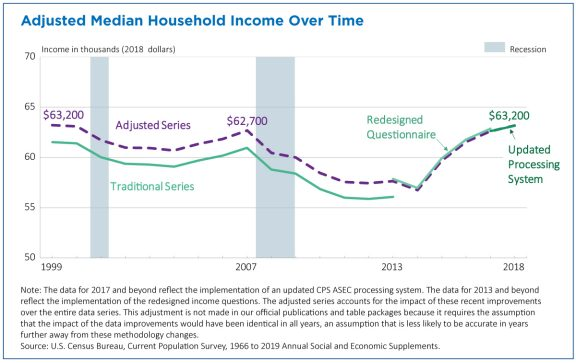
The “estimated adjusted” figures also show an even greater increase during Trump’s first two years than the official figures, because this year’s new data processing procedures had the effect of holding down income by a fraction of a percentage point. On an adjusted basis, the increase under Trump would be $1,638, or 2.7%.
Poverty — As incomes rose, the rate of poverty declined. The percentage of Americans living with income below the official poverty line went down to 11.8% of the population in 2018, the lowest level since 2001.
The poverty rate has now declined for four consecutive years, dropping by 1.3 percentage points in 2015, by 0.8 points in 2016 and by 0.4 points and 0.5 points in Trump’s first two years.
Regulations
The growth of federal regulation has stopped under Trump.
It wasn’t exactly the “sudden, screeching and beautiful halt” Trump prematurely claimed back in December 2017, when in fact the number of federal restrictions was still growing. But over the next several months the rise decelerated, and then reversed. The number of restrictions has now dropped to just below where it was when Trump was sworn in.
The number of restrictive words and phrases (such as “shall,” “prohibited” or “may not”) contained in the Code of Federal Regulations went up by 0.73% within Trump’s first 15 months, reaching a peak of nearly 1.09 million on April 6, 2018, according to daily tracking done by the QuantGov project at George Mason University’s Mercatus Center.
But as of Oct. 10, 2019, the number had dropped back below 1.08 million — 2,789 fewer than on Jan. 20, 2017, the day Trump took office.
In percentage terms, the drop is only 0.26% — barely one-quarter of 1 percentage point. But that’s a big change from the past. Restrictions grew at an average of 1.5% per year during both the Obama years and the George W. Bush years, according to annual QuantGov tracking.
The Mercatus count of restrictions doesn’t attempt to assess the cost or benefit of any particular rule — such assessments require a degree of guesswork and are sensitive to assumptions. But it does track the sheer volume of federal rules with more precision than we have found in other metrics.
Some of the recent changes are just clearing deadwood. In March, for example, the Internal Revenue Service removed 296 regulations that it said “are no longer necessary because they do not have any current or future applicability.” And last year the Treasury Department scrapped an entire chapter of zombie-like regulations issued by the old Office of Thrift Supervision, which oversaw the savings-and-loan industry before being abolished in 2011. S&Ls have since fallen under other federal banking regulators, but the obsolete OTS rules remained on the books.
However, many of the rules Trump has eliminated are quite significant.
Within a month of taking office, for example, Trump signed a law nullifying an Obama-era rule restricting coal mining companies from dumping waste into streams and waterways. Last year his administration proposed withdrawing Obama’s edict requiring automakers to increase the fuel efficiency of new cars and light trucks to 46.8 miles per gallon by the year 2025. Instead, the requirement would be capped at the 2020 level of 37 mpg. And in September the EPA’s Affordable Clean Energy rule took effect, repealing the Obama administration’s Clean Power Plan rule. The Obama-era rule was designed to reduce carbon dioxide emissions by shifting away from coal as an energy source and would have required states to meet specific emissions reductions.
Crime
Crime declined during Trump’s first two years, except for rape, which increased.
The FBI’s annual Crime in the United States report, released Sept. 30, shows 1,199 fewer murders were committed in 2018 than in 2016, when Trump was elected. That’s a decline of 6.9%.
But despite that decline, the murder rate per 100,000 people, which was 5.0 last year, still was above the record low set in 2014, when it was 4.4.
As a candidate, Trump repeatedly claimed that the murder rate was “the highest it’s been in 45 years.” That was far from true. The rate did rise during President Obama’s final two years, to 5.4 per 100,000 in 2016. But the highest rate in the past half century was 10.2 in 1980.
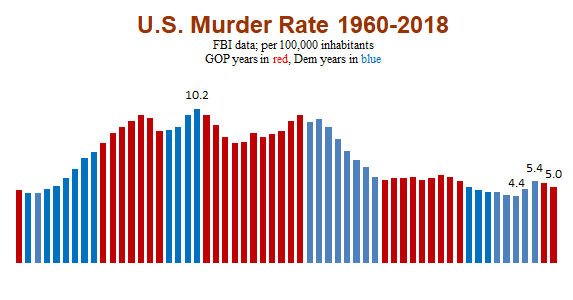
Overall, the rate of violent crimes per 100,000 people went down 4.6% during Trump’s first two years. That included a 16.2% drop in the robbery rate, and a 0.6% decline in the rate of aggravated assault.
However, the number of reported rapes per 100,000 people went up — by 4.2%. (A rise in rapes and sexual assault in 2018 was also noted in the National Crime Victimization Survey, released Sept. 10, which covers crimes that are not reported to police, as well as those that are.)
The number of property crimes per 100,000 people went down 10.3% during Trump’s first two years, including a 19.8% drop in the burglary rate, an 8.6% drop in the rate of larcenies (such as shoplifting), and a 3.5% decline in the rate of motor vehicle thefts.
Guns
Sales and production of guns pulled back under Trump, after surging to record levels during the Obama years.
Handgun Production — In 2018, annual production of pistols and revolvers in the U.S. totaled just under 4.3 million, according to preliminary figures from the Bureau of Alcohol, Tobacco, Firearms and Explosives, released July 22.
That represented a decline of 23% from 2016, when production surged to a record level of nearly 5.6 million.
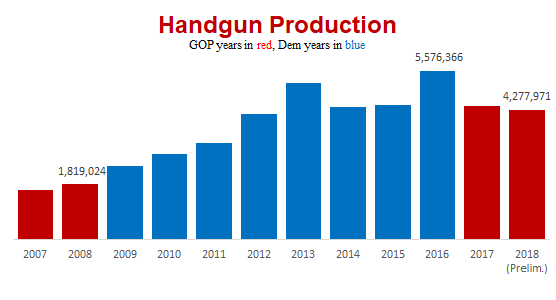
Handgun production more than tripled during the Obama years. So the 2018 level was still 135% higher than it had been in 2008, the last year of George W. Bush’s presidency.
Gun Sales — Gun sales also dropped — though the decline seems to have leveled off this year.
The government doesn’t collect figures on sales of guns. But the National Shooting Sports Foundation — the gun industry’s trade group — tracks approximate sales figures by adjusting FBI statistics on background checks to remove those not related to actual sales, such as checks required for concealed-carry permits.
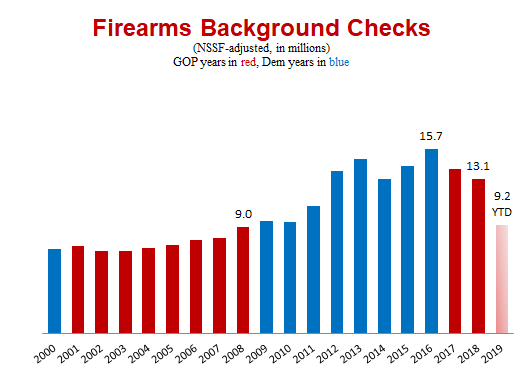
Those NSSF-adjusted figures dropped from a record 15.7 million in Obama’s final year to 13.1 million last year — a decrease of 16.5%.
Sales for this year have been mixed. They dropped further during the first half of the year but bounced back during the July-September quarter. The NSSF figures for the first six months of 2019 were 5.3% lower than for the same period in 2018. But the third-quarter figures were 9.1% higher than the year-earlier figures.
Overall, figures for the first nine months of 2019 were a scant 1.1% below the same period in 2018.
These figures cover rifles and shotguns and previously owned weapons, as well as new handguns. They are only an approximation of actual sales, since some of these checks cover purchases of multiple weapons, and of course some sales still occur without background checks.
Coal and Environment
Coal Mining Jobs — As a candidate, Trump promised to “put our [coal] miners back to work,” but so far not many have regained their jobs.
A total of 35,600 coal mining jobs disappeared during the Obama years, but as of September, only 2,500 of them had come back since Trump took office, according to BLS figures.
The outlook for coal miners remains bleak. The Energy Information Administration reports that U.S. consumption of coal reached a 39-year low last year. And EIA predicts that will fall another 10% this year, and 11% more in 2020. EIA expects natural gas will continue to displace coal for the generation of electricity.
Carbon Emissions — Carbon dioxide emissions from energy consumption have gone up under Trump, after falling for years before he took office.
Figures from the Energy Information Administration show CO2 emissions were 0.9% higher in the most recent 12 months on record (ending in June) than they were in 2016.
In the decade before Trump took office, emissions fell by a total of 14.5%, due mainly to electric utilities shifting away from coal-fired plants in favor of cheaper, cleaner natural gas, as well as solar and wind power. Under Trump, the trend first slowed — emissions fell only 0.8% in 2017 — and then reversed entirely — rising 2.7% in 2018.
The 2018 rise is turning out to be a temporary blip — brought on by a hotter summer and colder winter than normal, resulting in higher natural gas consumption. EIA is currently predicting that CO2 emissions will fall by 2.4% in 2019 — if temperatures return to normal as forecast. But so far, there has been a net gain in total carbon emissions since Trump took office.
Border Security
Illegal border crossings surged under Trump, to the highest levels in well over a decade, but have dropped considerably in recent months.
In May, 132,859 people were apprehended trying to cross the U.S.-Mexico border without permission, according to U.S. Customs and Border Protection. That was the highest total since March 2006, when the monthly total hit nearly 161,000.
But monthly apprehensions fell in each of the next three months, totaling 50,693 in August.
That still leaves the average monthly total for this year at 82,176. That is higher than the monthly average for any full year since 2006, when it hit 84,800.
For the most recent 12 months on record, the monthly average was 71,042 which is 92.5% higher than the monthly average of 36,912 in 2016. We use this rolling monthly average for our chart, because these monthly figures are subject to wide seasonal variations.
Of those apprehended in August, 43% were single adults. The rest, nearly 57%, were either unaccompanied children or part of “family units” made up of a child under 18 accompanied by a parent or guardian. Border Patrol officials said they are coming primarily from Guatemala, Honduras and El Salvador, and many are seeking asylum. It’s a big change from the days when most such attempted border crossings were made by Mexican males seeking work.
Corporate Profits
After-tax corporate profits are running at near record levels under Trump. During 2018, they hit $1.84 trillion for the year, just under the record $1.86 trillion recorded for 2014. During the second quarter of 2019, profits still were running at a yearly rate of $1.86 trillion.
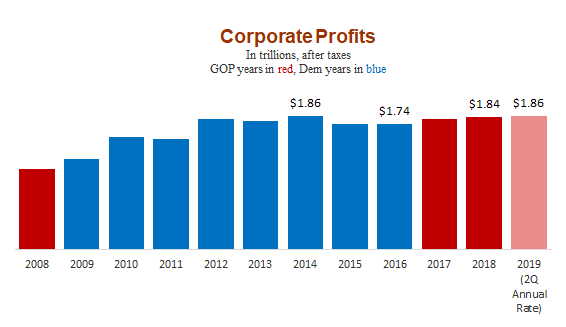
Since our last report — when we said profits in 2018 set a record $1.95 trillion — the Bureau of Economic Analysis revised its annual and quarterly estimates of after-tax profits (on line 45) as part of its annual update, using newly available data to refine its estimates for the previous five years. The 2018 figure was revised downward.
Still, the most recent quarter’s annual rate is 6.9% higher than the full-year figure for 2016, the year before Trump’s inauguration.
Stock Market
Stock prices continued their decade-long rise with Trump in office — but seem to have hit a ceiling since our last report.
Market indexes set record after record in 2018, only to plunge during the worst December since 1931 and then bounce back during the best first quarter in a decade, and go on to set new records in July, as we reported in our last update.
Stock prices have slipped downward a bit since then. But even so, at the close on Oct. 10, the Standard & Poor’s 500-stock average was 29.8% higher than it was on the last trading day before Trump’s inauguration.
Other indexes took similar rides. At the Oct. 10 close, the Dow Jones Industrial Average, made up of 30 large corporations, was up 34.3% under Trump. And the NASDAQ composite index, made up of more than 3,000 companies, closed on Oct. 10 at 43.5% higher than before Trump took office.
The bull market began its rise in the depths of the Great Recession in 2009, and became the longest in history last year. This year it passed its 10th anniversary in March.
Wages and Inflation
The upward trend in real wages continued under Trump, and inflation remained in check.
CPI — The Consumer Price Index rose 5.2% during Trump’s first 32 months, continuing a long period of historically low inflation.
In the most recent 12 months, ending in September, the CPI rose 1.7%. The CPI rose an average of 1.8% each year of the Obama presidency (measured as the 12-month change ending each January), and an average of 2.4% during each of George W. Bush’s years.
Wages — Paychecks continued to grow faster than prices.
The average weekly earnings of all private-sector workers, in “real” (inflation-adjusted) terms, rose 2.8% during Trump’s first 32 months (ending in September) after going up 3.9% during the previous four years.
Those figures are for all private-sector workers, including managers and supervisors.
For rank-and-file production and nonsupervisory workers (who make up 82% of all private-sector workers), real weekly earnings have gone up 3.2% so far under Trump, after rising 4.9% during Obama’s last four years in office.
Consumer Sentiment
Consumer confidence in the economy first rose, then sagged under Trump.
The University of Michigan’s Surveys of Consumers monthly index peaked at 101.4 in March of last year, which was the highest in 14 years. Since then it has gone down to 93.2 as of September — a decline of 5.3 points since Trump took office.
However, the most recent index is still 6.0 points above where it was in October 2016 — just before Trump was elected — after promising to boost economic growth to levels not seen in decades.
Home Prices and Ownership
Home Prices — Home prices soared to record levels under Trump.
Since our last report, the national median price of an existing, single-family home set another record, peaking at $288,500 in June, according to sales figures from the National Association of Realtors.
Lately prices have moderated a bit, but still stood at $280,700 in August, the most recent monthly figure available. That is $52,000 higher than the median price of $228,700 for homes sold during the month Trump took office — a gain in value of 22.7%. The rise in the Consumer Price Index during the same period was 5.1%.
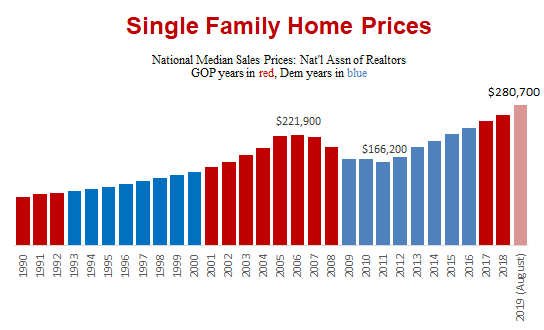
The Realtors’ figures reflect raw sales prices without attempting to adjust for such factors as variations in the size, location, age or condition of the homes sold in a given month or year. Even so, a similar pattern emerges from the S&P CoreLogic Case-Shiller U.S. National Home Price Index, which compares sales prices of similar homes and seeks to measure changes in the total value of all existing single-family housing stock.
The Case-Shiller index for July sales (the most recent available) was 14.6% above where it stood in the month Trump took office.
Whichever way you measure it, homeowners have seen the value of their houses rise substantially since Trump became president.
Homeownership — The percentage of Americans who own their homes at first continued to recover under Trump, but lately has taken a dip.
Back in 2004 the homeownership rate hit a record 69.2% of households for two quarters, but then began a years-long slide, hitting bottom in the second quarter of 2016 at 62.9%. That was the lowest point in more than half a century, and tied for the lowest on record.
The rate recovered 0.8 points in the six months before Trump took office, and went up another 1.1 points during his first two years, reaching 64.8% in the fourth quarter of 2018.
But most of that gain under Trump was erased in the first half of this year, according to the most recent Census Bureau figures.
The most recent rate, for the second quarter of 2019, stands at 64.1%. That’s 0.4 percentage point higher than the quarter before Trump took office, but still a full 5 points below the peak level of 15 years earlier.
Trade
The trade deficit that Trump promised to reduce grew much larger instead.
The most recent government figures show that the total U.S. trade deficit in goods and services during the most recent 12 months on record (ending in August) was $656 billion. That’s an increase of $153 billion, or 30.4%, compared with 2016.
China — The goods-and-services trade deficit with China grew at a somewhat slower pace, up by 17.2% between 2016 and the most recent 12 months on record (ending in June) when it hit $362 billion.
Trump last year initiated a full-scale trade conflict with China, imposing tariffs on $250 billion worth of Chinese goods. China has retaliated with its own tariffs on $110 billion of U.S. goods. Trump met personally with Chinese President Xi Jinping on June 29 in Osaka, Japan, but it remains to be seen how the trade war will be resolved, and what effect that might have on future trade.
Mexico — Meanwhile, the much smaller trade deficit in goods and services with Mexico totaled $92 billion during the 12 months ending in June, an increase of 49% compared with 2016.
Canada — The trade surplus that the U.S. runs with Canada has dwindled to nearly nothing under Trump. The trade balance was positive by $697 million during the 12 months ending in June. That surplus has shrunk by 90.6% since 2016.
On Nov. 30 last year Trump and the leaders of Canada and Mexico signed a new trade agreement to replace the 25-year-old North American Free Trade Agreement, which Trump had promised to scrap during his campaign. The new agreement will be called the United States-Mexico-Canada Agreement, or USMCA. The new agreement still requires approval by Congress before it can take effect. But Democrats who control the House want stronger enforcement for labor and environmental standards, and changes in patent protections for drug companies, and have not allowed a vote on the measure.
Health Insurance Coverage
The number of people lacking health insurance rose by nearly 2 million under Trump.
The U.S. Census Bureau reported Sept. 10 that the number of Americans who lacked health insurance for all of 2018 was 27.5 million — up from 25.6 million in 2017. It was the first time in a decade that this number increased. The percentage of Americans without coverage for the entire year rose to 8.5%, from 7.9% the year before.
The Census report confirmed a trend we’ve been tracking using a somewhat different measure released on a more frequent and timely basis by the National Health Interview Survey. As we reported in our July update, the NHIS put the number of people who lacked coverage at the time they were interviewed — not necessarily for the entire year — at 30.4 million in 2018, an increase of 1.8 million over 2016.
The NHIS said 9.4% of the population lacked coverage at the time of interview in 2018, up from 9% in 2016.
A much greater rise was reported by a Gallup survey covering the final quarter of 2018. Gallup on Jan. 23 put the rise in uninsured adults at about 7 million, compared with the last half of 2016. Gallup put the percentage of uninsured adults at 13.7% in the October-December quarter. For details, see our Feb. 12 story, “Did the Uninsured Increase by 7 Million?“
Trump failed to “repeal and replace” the Affordable Care Act as he promised to do, but did slash advertising and outreach aimed at enrolling people in Obamacare plans. In December 2017 he signed a tax bill that ended the ACA’s tax penalty for people who fail to obtain coverage, effective this year. And in March the Trump administration joined an effort by GOP state attorneys general seeking a court decision to overturn the entire act. That case, Texas v. U.S., was argued July 9 before the U.S. Court of Appeals in New Orleans. The court has not yet issued its ruling in that case.
Food Stamps
The number of food stamp recipients dropped to the lowest levels in a decade.
Earlier this year the number dropped below 37 million for the first time since October 2009, when millions were signing up for benefits in the aftermath of the Great Recession of 2007-2009.
As of July, the most recent month for which figures are available, 36.3 million people were receiving the aid.
The number of food stamp recipients has gone down 6.4 million, or 15.1%, since January 2017, when Trump took office.
The number of recipients is now 11.5 million below the peak month of December 2012. But it is still 8.9 million above where it was at the start of the Great Recession, in December 2007, despite years of an improving economy.
The administration is working to reduce the number further. A proposed rule to tighten work requirements for able-bodied adults without dependents would cause 755,000 individuals to lose eligibility, if and when it is implemented, the U.S. Department of Agriculture estimates.
And in July, the Trump administration proposed another rule that it said could remove another 3 million people from the rolls. That rule would take away flexibility that many states now use to grant food aid to people with income or assets exceeding federal limits.
Judiciary Appointments
Trump is putting his mark on the federal appeals courts more quickly than Obama was able to do in his time in office.
Supreme Court — So far Trump has won Senate confirmation for two Supreme Court nominees, Justice Neil M. Gorsuch and Justice Brett M. Kavanaugh.
Obama also was able to fill two high court vacancies during his first two years in office, with Justice Sonia Sotomayor and Justice Elena Kagan. But the Kavanaugh nomination to fill the vacancy created by Justice Anthony Kennedy’s retirement is significant because Kavanaugh may move the court to the right. He is considered to be more conservative than Kennedy, who sometimes sided with the liberal justices to provide deciding votes on issues including gay rights, abortion, capital punishment and affirmative action.
However, Kavanaugh disappointed abortion foes when he sided with the court’s liberals on one of his first votes, against taking up a case about whether citizens should be allowed to sue states that cut off Medicaid funding for Planned Parenthood health clinics.
Court of Appeals — Trump also won confirmation of 43 U.S. Court of Appeals judges (30 during his first two years and another 13 in the current Congress as of Oct. 7). That’s nearly double the total for Obama, who won confirmation for 25 as of the same point in his first term (16 during his first two years and nine more in the 112th Congress as of Oct 11, 2011).
Trump has now installed 24% of all the 179 appellate court judges authorized by federal law.
District Court — Trump also outpaced Obama on filling lower courts. Trump has won confirmation for 105 of his nominees to be federal District Court judges as of Oct. 7. That’s nearly 16% of the 677 authorized district judges. Obama had won confirmation for 87 at the same point in his presidency.
Trump has also filled two seats on the U.S. Court of Federal Claims, which has nationwide jurisdiction over lawsuits seeking money from the government. And he has filled two seats on the U.S. Court for International Trade. Obama had filled none at the same point in his first term.
Trump must share responsibility for this record with the Republican majority in the Senate. Republicans not only refused to consider Obama’s appointment of Merrick Garland to fill the Supreme Court vacancy eventually filled by Gorsuch, but they also blocked confirmation of dozens of Obama’s nominees to lower courts. Trump inherited 17 Court of Appeals vacancies, for example, including seven that had Obama nominees pending but never confirmed.
Federal Debt and Deficits
The federal debt went up more than $2 trillion under Trump, as trillion-dollar annual federal deficits returned. And there’s no end in sight.
The federal debt held by the public stood at $16.8 trillion at the last count on Oct. 9 — an increase of more than $2.4 trillion since he took office. That’s a 16.7% increase under Trump. And that figure will go up even more quickly in coming years unless Trump and Congress impose massive spending cuts, or reverse course and increase taxes.
Trump’s cuts in corporate and individual income tax rates — as well as the bipartisan spending deal he signed Feb. 9, 2018 — are causing the red ink to gush even faster than it did before.
The federal government’s annual deficit hit $779 billion in fiscal year 2018. CBO estimates that the deficit for fiscal year 2019 (which ended Sept. 30) was $984 billion, based on daily Treasury statements. (The Treasury Department will issue the final, official figure later this month.)
That’s 2.5% higher than CBO estimated as recently as Aug. 21, in its latest update of its Budget and Economic Outlook, when it projected a FY2019 deficit of $960 billion. In that report, CBO said that under current law annual deficits will top $1 trillion in the fiscal year that just started, and average $1.2 trillion each year from 2020 through 2029.
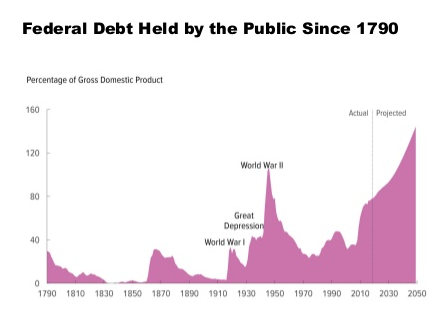
The debt is now equal to about 78% of the nation’s entire gross domestic product. CBO said Oct. 3 that if current laws aren’t changed, the debt “would approach 100 percent of GDP by the end of the next decade and 152 percent by 2048.” That would be far higher than the debt the U.S. ran up during World War II, which was the highest in the nation’s history.
Oil Production and Imports
U.S. crude oil production resumed its upward trend under Trump, rising 33.6% during the most recent 12 months on record (ending in July), compared with all of 2016.
Domestic oil production has increased every year since 2008, except for a 6.1% drop in 2016 after prices plunged to as low as $30 a barrel, from more than $100 in 2014. The price returned to more than $50 a barrel by the end of 2016, prompting increased drilling and production. The price has averaged nearly $58 since Trump took office.
As a result of this rising production, the trend to reduced reliance on foreign oil also resumed. The U.S. imported an estimated 11.4% of its oil and petroleum products last year — less than half of the 24.4% figure for all of 2016. That percentage has fallen further this year — to well under 10% for each month for which the EIA currently has estimates. And it may soon be zero before too long. The EIA projected in January that the U.S. would likely be exporting more petroleum than it imports by the end of 2020.
Dependence on imports peaked in 2005, when the U.S. imported 60.3% of its petroleum, and it has declined every year since except for 2016, when it ticked up by 0.3 percentage points.
Sources
Bureau of Labor Statistics. “Employment, Hours, and Earnings from the Current Employment Statistics survey (National); Total Nonfarm Employment, Seasonally Adjusted.” Data extracted 9 Oct 2019.
Bureau of Labor Statistics. “Labor Force Statistics from the Current Population Survey; Unemployment Rate, Seasonally Adjusted.” Data extracted 9 Oct 2019.
Bureau of Labor Statistics. “Job Openings and Labor Turnover Survey: Job Openings, Seasonally Adjusted.” Data extracted 9 Oct 2019.
Bureau of Labor Statistics. “Labor Force Statistics from the Current Population Survey; Labor Force Participation Rate.” Data extracted 9 Oct 2019.
Bureau of Labor Statistics. “Labor Force Statistics from the Current Population Survey; Unemployment Level, Seasonally Adjusted.” Data extracted 9 Oct 2019.
Bureau of Labor Statistics. “Labor Force Statistics from the Current Population Survey; All employees, thousands, manufacturing, seasonally adjusted.” Data extracted 9 Oct 2019.
Davidson, Paul. “More signs of recession? Slowing job growth, trade and factories add to economic worries.” USA Today. 1 Oct 2019.
U.S. Bureau of Economic Analysis. “Table 1.1.1. Percent Change From Preceding Period in Real Gross Domestic Product.” Interactive data extracted 4 Oct 2019.
Wall Street Journal. “WSJ Economic Forecast Survey.”
National Association of Business Economists. “NABE Outlook Survey – October 2019.”
U.S. Census Bureau. “Current Population Survey, 1966 to 2019 Annual Social and Economic Supplements.” 10 Sept 2019.
McLaughlin, Patrick A., and Oliver Sherouse. RegData US 3.1 Daily (dataset). QuantGov, Mercatus Center at George Mason University, Arlington, VA. Daily Summary tracking of restrictions in the eCFR (Electronic Code of Federal Regulations). Downloaded 9 Oct 2019.
McLaughlin, Patrick A. and Oliver Sherouse. RegData US 3.1 Annual (dataset). QuantGov, Mercatus Center at George Mason University, Arlington, VA.. “RegData 3.1 Annual Summary.” Downloaded 9 Oct 2019.
Federal Bureau of Investigation. “Crime in the United States 2018,” Table 1. 30 Sep 2019.
Bureau of Justice Statistics. “Homicide Trends in the United States, 1980-2008.” Nov 2011.
Bureau of Justice Statistics. “Criminal Victimization, 2018.” 10 Sep 2019.
Federal Bureau of Investigation. “Crime in the United States, Jan-Jun 2018, Preliminary Semiannual Uniform Crime Report.” 25 Feb 2019.
U.S. Bureau of Alcohol, Tobacco, Firearms and Explosives. “Annual Firearms Manufacturing and Export Report, Year 2018 Interim.” 22 Jul 2019.
U.S. Bureau of Alcohol, Tobacco, Firearms and Explosives. “Annual Firearms Manufacturing and Export Report, Year 2016 Final.” 4 Jan 2018.
U.S. Bureau of Alcohol, Tobacco, Firearms and Explosives. “Annual Firearms Manufacturing and Export Report, Year 2008 Final.” 8 Mar 2011.
National Shooting Sports Foundation. “National Shooting Sports Foundation® Report: NSSF-Adjusted NICS – Historical Monthly Chart.” Proprietary data supplied on request and posted with NSSF permission. 9 Oct 2019.
Bureau of Labor Statistics. “Labor Force Statistics from the Current Population Survey; All employees, thousands, coal mining, seasonally adjusted.” Data extracted 9 Oct 2019.
U.S. Energy Information Administration. Short Term Energy Outlook. Oct 2019.
U.S. Energy Information Administration. “Monthly Energy Review, June 2019: Table 6.1 Coal Review From Energy Consumption by Source.” Sep 2019.
U.S. Energy Information Administration. “Monthly Energy Review, September 2019: Table 11.1 Carbon Dioxide Emissions From Energy Consumption by Source.” Sep 2019.
U.S. Energy Information Administration. “U.S. Energy-Related Carbon Dioxide Emissions, 2017.” 25 Sep 2018.
U.S. Border Patrol. “U.S. Border Patrol Apprehensions FY2019.” 9 Sep 2019.
U.S. Border Patrol. “Total Illegal Alien Apprehensions By Month Fiscal Years 2000-2018.” Undated. Accessed 10 Oct 2019.
U.S. Bureau of Economic Analysis. Corporate Profits After Tax (without IVA and CCAdj) (CP), retrieved from FRED, Federal Reserve Bank of St. Louis. 9 Oct 2019.
U.S. Bureau of Economic Analysis. “National Income and Products Accounts, Table 1.12. National Income by Type of Income, Annual.” 26 Sep 2019.
U.S. Bureau of Economic Analysis. “National Income and Products Accounts, Table 1.12. National Income by Type of Income, Quarterly.” 26 Sep 2019.
Shell, Adam. “S&P 500 hits record high as earnings eclipse trade war fears.” USA Today. 21 Aug 2018.
O’Halloran, Suzanne. “Dow, S&P 500 post worst December since 1931, as Nasdaq has worst on record.” Fox Business. 31 Dec 2018.
Davidson, Paul. “401(k) investors: Stocks had their best quarter in a decade. Can they continue to climb?” USA Today. 29 Mar 2019.
Troise, Damian J. “July 3rd stock market fireworks: Dow, S&P 500, Nasdaq set records.” Chicago Tribune. 3 Jul 2019.
Yahoo! Finance. “Dow Jones Industrial Average.” Accessed 9 Oct 2019.
Yahoo! Finance. “S&P 500.” Accessed 9 Oct 2019.
Yahoo! Finance. “NASDAQ Composite.” Accessed 9 Oct 2019.
Smith, Adam. “Wall Street’s Bull Market Celebrates Its 10th Anniversary.” The Street. 10 Mar 2019.
Eagan, Matt. “Market milestone: This is the longest bull run in history.” CNN.com. 22 Aug 2018.
Bureau of Labor Statistics. “Consumer Price Index – All Urban Consumers.” Data extracted 9 Oct 2019.
Bureau of Labor Statistics. “Employment, Hours, and Earnings from the Current Employment Statistics survey (National); Average Weekly Earnings of All Employees, 1982-1984 Dollars.” Data extracted 9 Oct 2019.
Bureau of Labor Statistics. “Employment, Hours, and Earnings from the Current Employment Statistics survey (National); Average Weekly Earnings of production and nonsupervisory employees, 1982-1984 Dollars.” Data extracted 9 Oct 2019.
University of Michigan Surveys of Consumers. “The Index of Consumer Sentiment.” Sep 2019.
National Association of Realtors. “Sales Price of Existing Single-Family Homes.” 19 Sep 2019.
S&P Dow Jones Indices. “S&P CoreLogic Case-Shiller U.S. National Home Price NSA Index.” Data extracted 9 Oct 2019.
U.S. Census Bureau. “Time Series: Not Seasonally Adjusted Home Ownership Rate.” Data extracted 9 Oct 2019.
U.S. Bureau of Economic Analysis. “U.S. International Trade in Goods and Services, May 2019.” 4 Oct 2019.
U.S. Bureau of Economic Analysis. “Table 1, U.S. Trade in Goods and Services, 1992-present.” 4 Oct 2019.
U.S. Bureau of Economic Analysis. “Table 3. U.S. International Trade by Selected Countries and Areas: Balance on Goods and Services.” 4 Oct 2019.
Galwitz, Phil. “Breaking A 10-Year Streak, The Number Of Uninsured Americans Rises.” Kaiser Health News. 10 Sep 2019.
Berchick, Edward R. et al. “Health Insurance Coverage in the United States: 2018.” U.S. Census Bureau. 10 Sep 2019.
Centers for Disease Control and Prevention; National Health Interview Survey. “Health Insurance Coverage: Estimates From the National Health Interview Survey, 2018.“ 9 May 2019.
Witters, Dan. “U.S. Uninsured Rate Rises to Four-Year High.” Gallup. 23 Jan 2019.
Kliff, Sarah. “Trump is slashing Obamacare’s advertising budget by 90%.” Vox.com. 31 Aug 2017.
Lee, MJ et al. “GOP Obamacare repeal bill fails in dramatic late-night vote.” CNN.com. 28 Jul 2017.
Mukherjee, Sy. “The GOP Tax Bill Repeals Obamacare’s Individual Mandate. Here’s What That Means for You.” Fortune. 20 Dec 2017.
Haberman, Maggie and Robert Pear. “Trump Sided With Mulvaney in Push to Nullify Health Law.” The New York Times. 27 Mar 2019.
The National Bureau of Economic Research. “US Business Cycle Expansions and Contractions.” Accessed 9 Oct 2019.
Levey, Noam V. “Federal appeals court appears skeptical of Obamacare, putting future of law in doubt.” Los Angels Times. 10 Jul 2019.
U.S. Department of Agriculture, Food and Nutrition Service. “Supplemental Nutrition Assistance Program (Data as of October 04, 2019).” Data extracted 9 Oct 2019.
U.S. Department of Agriculture, Food and Nutrition Service. Supplemental Nutrition Assistance Program (SNAP) data, FY 69 through FY18 National View Summary. ZIP Excel files. Accessed 9 Oct 2019
U.S. Department of Agriculture. “USDA to Restore Original Intent of SNAP: A Second Chance, Not A Way of Life.” 20 Dec 2018.
Reiley, Laura. “Trump proposal would push 3 million Americans off food stamps.” Washington Post. 23 Jul 2019.
U.S. White House. “President Donald J. Trump Announces Intent to Nominate Judge Brett M. Kavanaugh to the Supreme Court of the United States.” 9 Jul 2018.
Kennedy, Anthony M., Letter to the President of the United States. 27 Jul 2018.
Liptak, Adam. “How Brett Kavanaugh Would Transform the Supreme Court.” New York Times. 2 Sep 2018.
Ralph, Paul. “6 times Justice Kennedy was the tipping point on the Supreme Court shows how consequential his retirement is.” 1 Jul 2018.
Gee v. Planned Parenthood of Gulf Coast, Inc. No. 17-1492. Supreme Court of the United States. 10 Dec 2018.
Susan B. Anthony List. “SBA List Statement on Supreme Court Decision Declining Cases on Taxpayer Funding for Planned Parenthood.” 10 Dec 2018.
Administrative Office of the U.S. Courts. “Judicial Confirmations for January 2019,” archived web listing of confirmations in 115th Congress. Accessed 9 Oct 2019.
Administrative Office of the U.S. Courts. “Confirmation Listing” web listing of confirmations in 116th Congress. Accessed 9 Oct 2019.
Administrative Office of the U.S. Courts. “Judicial Confirmations for January 2011,” archived web listing of confirmations in 110th Congress. Accessed 9 Oct 2019.
Administrative Office of the U.S. Courts. “Judicial Confirmations for January 2013,” archived web listing of confirmations in 111th Congress. Accessed 9 Oct 2019.
U.S. Treasury. “The Debt to the Penny and Who Holds It.” Data extracted 9 Oct 2019.
Congressional Budget Office. “Budget Review for September 2019.” 7 Oct 2019.
U.S. Treasury. “Final Monthly Treasury Statement of Receipts and Outlays of the United States Government For Fiscal Year 2017 Through September 30, 2017.” 20 Oct 2017.
Congressional Budget Office. “An Update to the Budget and Economic Outlook: 2019 to 2029.” 21 Aug 2019.
Gullo, Theresa. “The 2019 Long-Term Budget Outlook.” 3 Oct 2019.
U.S. Energy Information Administration. “U.S. Field Production of Crude Oil.” Accessed 9 Oct 2019.
U.S. Energy Information Administration. “Weekly Cushing, OK WTI Spot Price FOB.” Weekly oil price data. Accessed 9 Oct 2019.
U.S. Energy Information Administration. “U.S. Crude Oil Rotary Rigs in Operation.” Accessed 9 Oct 2019.
U.S. Energy Information Administration. “Table 3.3a Petroleum Trade: Overview.” Monthly Energy Review. Accessed Sept 2019.
U.S. Energy Information Administration. “Annual Energy Outlook 2019.” 24 Jan 2019.
